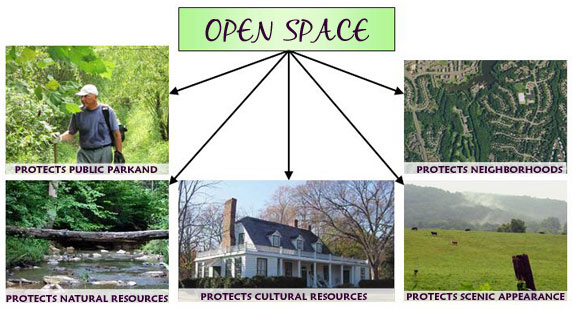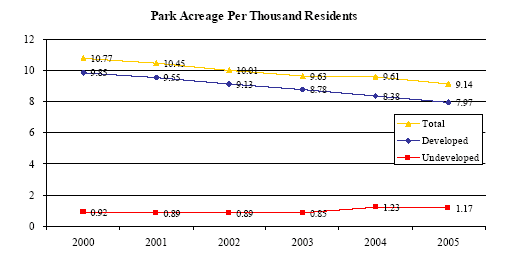The Planning Commission is revising the Parks and Open Space chapter in the current Comprehensive Plan. The revision for this chapter began in December 2004, when the American Farmland Trust and the Chesapeake Bay Foundation published the report Conserving the Washington-Baltimore Region's Green Network, where Prince William land conservation efforts reflected poorly on the County when compared to other localities in the region.
Many citizens, however, were already concerned. For seven years the County's Citizen Satisfaction Surveys have reported statistically significant drops in satisfaction with the County's efforts to preserve open space, which has dropped by 18 percentage points since 1999.
The County's 2005 Service Efforts and Accomplishments (SEA) report reinforces the validity of citizens concern that the County was neglecting parks and open space needs. The 2005 SEA report shows that, since 2000, the total park acreage per 1,000 residents actually dropped by nearly two acres, down to only 9.14 acres per 1,000 residents. The report also shows that 9.14 acres/1,000 is considerably less than what exists in the localities used for comparison (Fairfax, Loudoun and Virginia Beach). Click here for more information and graphs.
On December 14 2004, the Board of Supervisors expressed concern and directed staff to initiate a special project to assess parks and open space conditions and needs in Prince William County. The findings from this project set the stage for a new plan to protect parks and open space in Prince William County. On June 6 2006, the BOS formally initiated an update for the Parks and Open Space Chapter of the Comprehensive Plan. Click here to read the resolution and here to read the staff report.
What's Happening Now
Click here for information about the Feb. 18 2007 Public Meeting!
The Planning Commission has already "deferred" (i.e., rejected rather
than approved) two drafts presented by the Planning Department.
The first deferral came after Prince William Conservation Alliance
members and friends spoke at a regular Planning Commission
meeting on September 20, 2006. Citizens expressed their concerns that the goals proposed in the September
draft were set too low, definitions for key terms were missing and substituting private lands for public parks was not acceptable. Even if the draft had been "successful" over
the next 25 years, the county would have ended up with too few parks
and too little open space.
After a series of meetings with citizen groups and a public presentation at
the Park Authority offices on November 29, 2006, the staff released a
new draft on January 18, 2007. That version was also deferred unanimously
by the Planning Commission at a special hearing on January 24, after more than
40 citizens, including representatives from eight local organizations, spoke for two hours in opposition. This time, no date for another review for the plan was set and the Commissioners again said that additional community input was needed.
The County is proposing a "rolling" review of the Comprehensive Plan, with each chapter considered and updated in isolation from the rest of the plan. The Parks and Open Space Chapter is the first chapter being reviewed using this process. No Citizen Advisory Committee was formed and none are being planned for the rest of the chapters. Instead, "focus groups" are planned, but given the problems with this process during the Parks and Open Space review, many are concerned that the community will have few opportunities to participate in the Comprehensive Planning process.
What's Wrong with the Draft Plan?
What was wrong with the January 2007 draft, as well as the September
2006 version? Why did so many people drive to the McCoart
Administrative Center on two different occasions and speak out? (One person
said she hated public speaking and would rather be at the dentist, but
then spoke eloquently for three minutes to register her desire for a
plan that "aimed higher.")
There was inadequate time for public review of either draft.
- The September draft was completed after a series of work sessions
where county staff gathered public input, but the draft was not
released for public review until less than one week before the meeting.
- After the deferral in September, the Planning Department staff
spent a lot of time gathering input. However, because the County did not release the draft plan in a timely manner, citizens had less than a week to discover how their input had been
incorporated or omitted from the new draft.
- Planning staff did not reveal their projections of the fiscal impacts of
implementing the draft until the presentation at the January 24 2006 Planning Commission meeting. Also, since fiscal impacts are not considered in any other chapter of the Comprehensive Plan, it is not clear why Planning staff included this information.
Draft Plan omits (does not incorporate) most of
the ideas submitted by the citizens.
- Although records of the citizen input provided prior to the September draft were lost, the people who spoke at the Planning Commission in September made clear
that the first draft did not reflect what had been suggested.
- Documentation of citizen input was more complete for the second
draft, but all the citizens who spoke on January 24 made it clear that the
draft plan did not match what people wanted for parks and open space
in Prince William County .
Confuses definitions and goals for Parks with those for Open Space.
- Parks and Open Space are fundamentally different.
Parks are places open to the
public for active and passive recreation.
Open Space protects natural and cultural resources, scenic viewsheds, tree canopy coverage, and other important community resources such as Resource Preservation Areas. It must be permanently protected for open space uses but could be privately owned.
- The draft proposal did not distinguish goals and action strategies
separately. What Levels of Service would be required
to meet the different goals was poorly defined, confusing and appeared to include conflicting information.

Uses inconsistent and conflicting baseline data.
- No inventory of parks and open space was provided, and acreage
statistics for each category were not consistent.
- In the September draft, lands outside the county (in the city of
Manassas Park) were included in the county statistics. Both of the
draft plans provided an orientation map, but lacked sufficient detail
for anyone to determine if the definitions were applied consistently.
- In particular, the January draft did not identify clearly the
locations of the areas defined as open space protected against further
development, such as the acreage included within Home Owner
Association (HOA) or "subdivision" lands.
Uses inconsistent and conflicting definitions for key terms.
- Parks were defined as areas open to the public, but then properties owned by Homeowner Associations
were counted for neighborhood parks.
- Open space was defined as areas protected from development, but the
acceptable forms of protection were not defined. It appeared that all
acreage owned by an Homeowners Association was assumed to be "protected."
- Trail and environmental corridors were not defined, leaving some
citizens to challenge the credibility of the numbers.
Proposes that the County abdicate its responsibility to provide small "neighborhood" parks to private Home Owner Associations.
- The draft proposed that neighborhood parks, which are supposed to be approximately 1 acre, should be provided by HOA's without considering the fact that the County could not
require public access to such parks; gates could be locked to exclude
everyone except HOA members.
Lower standards for Protected Open Space.
- The draft proposed that 10% of the county should be open space,
after excluding Federal lands from the equation. It was very
difficult to assess the impact of adopting this percentage, since so
little time was provided for public review, but there is certainly a strong appearance that the
county already meets the 10% standard (assuming the existing Resource
Preservation Areas won't be violated by future development).
Therefore, if adopted, the 10% standard would eliminate the need to
set aside any open space in the site plans for future subdivisions or
commercial/industrial developments.
Draft plans lower standards for Parks and Recreation facilities.
- The draft exempted developers from providing public neighborhood
parks, and set a standard far lower than what citizens proposed at
public meetings and workshops. Fairfax County has acquired 10% of the
county land for the Fairfax County Park Authority, in addition to the
state, Federal, and regional parkland also available for public use.
The draft plan proposed a goal for Prince William that was less than
half of what Fairfax has already accomplished.
- In PWC, developed park acreage per
thousand residents actually decreased by
15 and 27 percent respectively
from 2000 to 2005. During the
same period undeveloped
acreage per 1,000 residents
increased 27 percent. Some of the land that is not developed is not developable. It is in small parcels or
locations that are not practical to develop. Prince
William has less total park acreage per 1,000 residents than the comparison jurisdictions (Fairfax, Loudoun and Virginia Beach). Source: 2005 Service Efforts and Accomplishments Report

Fails to integrate trails planning or identify regional connections.
- The trails corridor map is too vague, and could not guide any
future rezonings or site plan approvals. The language was even more
generic, with no focus on establishing a network of trails that would
be linked together over the next 25-30 years addressed in the Comp
Plan.
- No action plan was proposed to integrate the sketchy trails plan
with plans of adjacent cities or counties. There was no mechanism
established for partnering with HOA's or other non-government
organizations to create public trails to connect places such as the
Brentsville historic courthouse district with the new county-owned
facilities at Bristoe battlefield.
Abandons "underserved" neighborhoods.
- The draft plan did not identify the underserved areas in the county or include provisions to address these areas.
- In addition, by suggesting neighborhood parks should be
provided by Homeowner Associations, the plan assumes there will be no opportunities to correct for the failure
of earlier development to meet Level of Service requirements in
existing developed areas.
Creates confusion with other chapters of the Comprehensive Plan.
- The revision of the definition for "open space" required a revision
of the Environment and Cultural Resources chapters. It was not
evident if changing the definitions would have a larger impact on
those two chapters, or on other chapters such as the Land Use and Transportation chapters, which include the many miles
of paved trail that are being built on the side of highways such as the
Prince William Parkway.